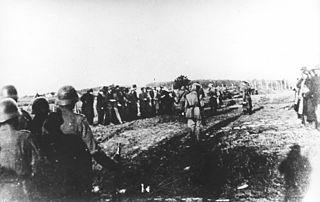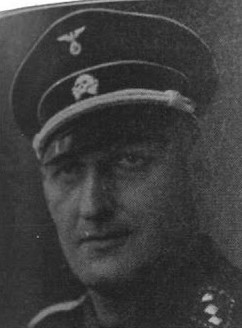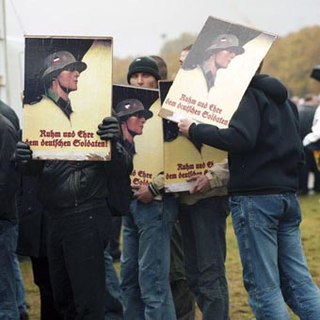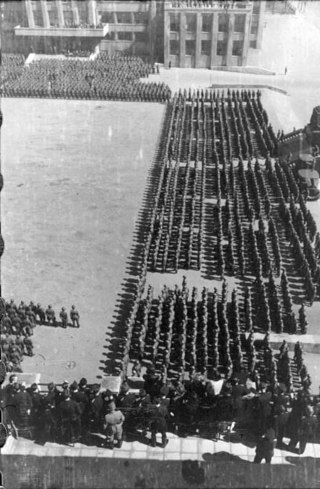
Georg Carl Wilhelm Friedrich von Küchler was a German Generalfeldmarschall of the Wehrmacht during the Second World War, who was subsequently convicted of war crimes. He commanded the 18th Army and Army Group North during the Soviet-German war of 1941–1945.

The Commissar Order was an order issued by the German High Command (OKW) on 6 June 1941 before Operation Barbarossa. Its official name was Guidelines for the Treatment of Political Commissars. It instructed the Wehrmacht that any Soviet political commissar identified among captured troops be summarily executed as a purported enforcer of the so-called Judeo-Bolshevism ideology in military forces. It is one of a series of criminal orders issued by the Nazi leadership.

Franz Friedrich Böhme was an Army officer who served in succession with the Austro-Hungarian Army, the Austrian Army and the German Wehrmacht. He rose to the rank of general during World War II, serving as Commander of the XVIII Mountain Corps, Hitler's Plenipotentiary Commanding General in the Balkans, and commander-in-chief in German-occupied Norway during World War II. After the war, Böhme was transferred to U.S. custody as a defendant in the Hostages Trial on charges of having massacred thousands of Serbian civilians. He committed suicide in prison.

During World War II, the German Wehrmacht committed systematic war crimes, including massacres, mass rape, looting, the exploitation of forced labour, the murder of three million Soviet prisoners of war, and participated in the extermination of Jews. While the Nazi Party's own SS forces was the organization most responsible for the Holocaust, the regular armed forces of the Wehrmacht committed many war crimes of their own, particularly on the Eastern Front.
In World War II, many governments, organizations and individuals collaborated with the Axis powers, "out of conviction, desperation, or under coercion." Nationalists sometimes welcomed German or Italian troops they believed would liberate their countries from colonization. The Danish, Belgian and Vichy French governments attempted to appease and bargain with the invaders in hopes of mitigating harm to their citizens and economies.

The Territory of the Military Commander in Serbia was the area of the Kingdom of Yugoslavia that was placed under a military government of occupation by the Wehrmacht following the invasion, occupation and dismantling of Yugoslavia in April 1941. The territory included only most of modern central Serbia, with the addition of the northern part of Kosovo, and the Banat. This territory was the only area of partitioned Yugoslavia in which the German occupants established a military government. This was due to the key rail and the Danube transport routes that passed through it, and its valuable resources, particularly non-ferrous metals. On 22 April 1941, the territory was placed under the supreme authority of the German military commander in Serbia, with the day-to-day administration of the territory under the control of the chief of the military administration staff. The lines of command and control in the occupied territory were never unified, and were made more complex by the appointment of direct representatives of senior Nazi figures such as Reichsführer-SS Heinrich Himmler, Reichsmarschall Hermann Göring, and Reichsminister Joachim von Ribbentrop. The Germans used Bulgarian troops to assist in the occupation, but they were at all times under German control. Sources variously describe the territory as a puppet state, a protectorate, a "special administrative province", or describe it as having a puppet government. The military commander in Serbia had very limited German garrison troops and police detachments to maintain order, but could request assistance from a corps of three divisions of poorly-equipped occupation troops.

The Kragujevac massacre was the mass murder of between 2,778 and 2,794 mostly Serb men and boys in Kragujevac by German soldiers on 21 October 1941. It occurred in the German-occupied territory of Serbia during World War II, and came as a reprisal for insurgent attacks in the Gornji Milanovac district that resulted in the deaths of ten German soldiers and the wounding of 26 others. The number of hostages to be shot was calculated as a ratio of 100 hostages executed for every German soldier killed and 50 hostages executed for every German soldier wounded, a formula devised by Adolf Hitler with the intent of suppressing anti-Nazi resistance in Eastern Europe.

Harald Turner was a German lawyer, civil servant and Nazi Party politician. He was also an SS-Gruppenführer in the Territory of the Military Commander in Serbia during the Second World War. From 1941 to 1942, as head of the German Military Administration's staff in Belgrade, Turner played a leading role in the murder of Jews and Roma. In addition, in 1944, as deputy head of the SS Race and Settlement Main Office, he was instrumental in executing Germanization policy, particularly in the General Government and the Soviet Union. He was executed in Belgrade for his war crimes.
The Geheime Feldpolizei, shortened to GFP, was the secret military police of the German Wehrmacht until the end of the Second World War (1945). Its units carried out plainclothes and undercover security work in the field. Their operations included clandestine operations, counterpropaganda, counterinsurgency, counterintelligence, creation of a counterinsurgency intelligence network, detection of treasonable activities, infiltration of resistance movements, gathering intelligence and destroying targets, protecting military installations, assisting the German Army (Heer) in courts-martial investigations, tracking and raiding targets to capture or kill, and setting-up security checkpoints in high-risk areas. GFP personnel, who were also classed as Abwehrpolizei, operated as an executive branch of the Abwehr, detecting resistance activity in Germany and in occupied France. They were known to carry out torture and executions of prisoners.

The Wehrmacht were the unified armed forces of Nazi Germany from 1935 to 1945. It consisted of the Heer (army), the Kriegsmarine (navy) and the Luftwaffe. The designation "Wehrmacht" replaced the previously used term Reichswehr and was the manifestation of the Nazi regime's efforts to rearm Germany to a greater extent than the Treaty of Versailles permitted.

Rudolf Querner was a German SS functionary during the Nazi era. He served as the Higher SS and Police Leader in Austria and Germany and was responsible for the evacuations and death marches from concentration camps at the end of the war. Arrested by the Allied authorities, he committed suicide in prison.

The Holocaust in German-occupied Serbia was part of the European-wide Holocaust, the Nazi genocide against Jews during World War II, which occurred in the Territory of the Military Commander in Serbia, the military administration of the Third Reich established after the April 1941 invasion of Yugoslavia. The crimes were primarily committed by the German occupation authorities who implemented Nazi racial policies, assisted by the collaborationist forces of the successive puppet governments established by the Germans in the occupied territory.
The Commissioner Government was a short-lived Serbian collaborationist puppet government established in the German-occupied territory of Serbia within the Axis-partitioned Kingdom of Yugoslavia during World War II. It operated from 30 April to 29 August 1941, was headed by Milan Aćimović, and is also referred to as the Commissars Government or Council of Commissars. Of the ten commissioners, four had previously been ministers in various Yugoslav governments, and two had been assistant ministers. The members were pro-German, anti-semitic and anti-communist, and believed that Germany would win the war. The Aćimović government lacked any semblance of power, and was merely an instrument of the German occupation regime, carrying out its orders within the occupied territory. Under the overall control of the German Military Commander in Serbia, supervision of its day-to-day operations was the responsibility of the chief of the German administrative staff, SS-Brigadeführer and State Councillor Harald Turner. One of its early tasks was the implementation of German orders regarding the registration of Jews and Romani people living in the territory, and the placing of severe restrictions on their liberty.
Walter Braemer was a general in the Reichswehr and the Wehrmacht and a high-ranking SS commander during the Nazi era. He was a Nazi criminal responsible for mass murders of the civilian population of Bromberg/Bydgoszcz in Poland at the outset of the Second World War, and later for crimes against humanity in the Holocaust in the Soviet Union. He escaped prosecution and punishment after the war despite having been held for 2+1⁄2 years as a prisoner of war by the British.

August Edler von Meyszner was an Austrian Gendarmerie officer, right-wing politician, and senior Ordnungspolizei officer who held the post of Higher SS and Police Leader in the German-occupied territory of Serbia from January 1942 to March 1944, during World War II. He has been described as one of Reichsführer-SS Heinrich Himmler's most brutal subordinates.

Helmuth Wilberg was a German officer and a Luftwaffe General of the Air Force during the Second World War. He helped develop the German strategy of blitzkrieg.

The myth of the clean Wehrmacht is the negationist notion that the regular German armed forces were not involved in the Holocaust or other war crimes during World War II. The myth, heavily promoted by German authors and military personnel after World War II, completely denies the culpability of the German military command in the planning and perpetration of war crimes. Even where the perpetration of war crimes and the waging of an extermination campaign, particularly in the Soviet Union – the populace of which was viewed by the Nazis as "sub-humans" ruled by "Jewish Bolshevik" conspirators – has been acknowledged, they are ascribed to the "Party soldiers corps", the Schutzstaffel (SS), but not the regular German military.

The Kraljevo massacre was the World War II mass murder of approximately 2,000 residents of the city of Kraljevo in the German-occupied territory of Serbia between 15 and 20 October 1941 by the German Army. The massacre came in reprisal for a joint Partisan–Chetnik attack on a German garrison during the Siege of Kraljevo in which 10 German soldiers were killed and 14 wounded. The number of hostages to be shot was calculated based on a ratio of 100 hostages executed for every German soldier killed and 50 hostages executed for every German soldier wounded, a formula devised by Adolf Hitler with the intent of suppressing anti-Nazi resistance in Eastern Europe.

In German military history, Bandenbekämpfung, also referred to as Nazi security warfare during World War II, refers to the concept and military doctrine of countering resistance or insurrection in the rear area during wartime with extreme brutality. The doctrine provided a rationale for disregarding the established laws of war and for targeting any number of groups, from armed guerrillas to civilians, as "bandits" or "members of gangs". As applied by the German Empire and later Nazi Germany, it became instrumental in the crimes against humanity committed by the two regimes, including the Herero and Nama genocide and the Holocaust.

Order Police battalions were battalion-sized militarised units of Nazi Germany's Ordnungspolizei which existed during World War II from 1939 to 1945. They were subordinated to the Schutzstaffel and deployed in areas of German-occupied Europe, specifically the Army Group Rear Area Commands and territories under civilian administration. Alongside the Einsatzgruppen, Waffen-SS and Wehrmacht, these units were involved in perpetrating the Holocaust and were responsible for large-scale crimes against humanity against civilian populations under German occupation.
















